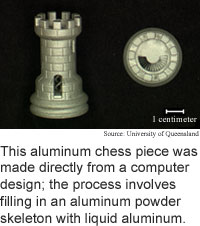
Rapid Process Shapes Aluminum
One key to making inexpensive metal parts is being able to quickly manufacture intricate shapes. Rapid prototyping processes are routinely used for plastics and some metals, but aluminum has proved elusive.
Aluminum is tricky because it conducts heat very quickly and is also highly reflective, making it difficult to turn powdered aluminum to liquid with lasers.
Researchers from the University of Queensland in Australia have come up with a rapid manufacturing process for aluminum that infiltrates an aluminum alloy powder with a liquid aluminum alloy.
The process paves the way for fast, inexpensive manufacturing of aluminum prototypes and parts. Objects made using the process have the same properties as ordinary cast aluminum, but can contain more complex shapes and smaller features, according to the researchers.
The process is similar to the rapid prototyping method used for steel, which infiltrates steel power with bronze. The process also adapts rapid prototyping methods for manufacturing parts from computer-generated designs.
The trick to adapting these methods to aluminum was first forming
an object using a combination of aluminum powder and resin. At the start
of the infiltration process the heat burns off the resin but hardens the
powder in time to hold the object's shape.
The system could be ready for commercial use in one or two years,
according to the researchers. The work appeared in the August 29 issue
of Science.
Radio tags give guidance
Laser made from single atom
Web searches tap databases
Heated plastic holds proteins
News briefs:
Reflective dust IDs substances
Rapid process shapes aluminum
3D display goes deeper
Artificial DNA stacks metal atoms
Teamed lasers make smaller spots
Glow shows individual DNA

Research Watch blog
View from the High Ground Q&A
How It Works
RSS Feeds:
News
Ad links:
Buy an ad link
Ad links: Clear History
Buy an ad link
|
TRN
Newswire and Headline Feeds for Web sites
|
© Copyright Technology Research News, LLC 2000-2010. All rights reserved.